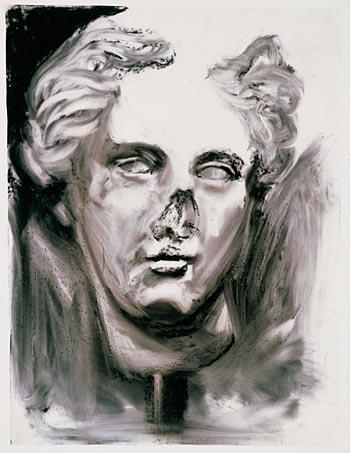
The flower delights my body's force.
It shines on the bitter-sweet limbs
Of our long companionship.
Moonlight covers the earth.
Jim Dine, "After Sappho," 1988
Read about materials and methods »
Painter, sculptor, draftsman, and poet, Jim Dine (American, born 1935) began his career in the early 1960s as a key figure in the development of performance art. He soon came to be associated with Pop Art because his drawings and paintings often depict a single object or everyday motif in isolation. Yet, in contrast to Pop, Dine charges his art with a deep personal investment, reworking and reimagining his sources until they become part of his own iconography. In the 1970s, draftsmanship became central to his practice, particularly in the form of life drawing, and in the 1980s he began a sustained series of drawings based on ancient sculpture.
In 1984, when Jim Dine first visited Munich's Glyptothek, a museum dedicated to antique sculpture, he was compelled to create a book of prints to house, in his own words, "my Glyptothek." In preparation for the prints he produced a series of forty drawings based on ancient sculpture, known as the Glyptotek Drawings. The entire suite forms a single work. "I think each individual drawing could stand alone," Dine said, "but as a single work all forty make a narrative about learning from the Ancient World." While the Munich museum sparked Dine's creative process, he made the drawings in his studio from in-situ sketches, photographs, postcards, and catalogues, incorporating ancient marbles from other museum collections as well.
Dine produced a number of other drawings related to the Glyptotek Drawings. Invited by the museum's director, Dine returned to the Munich Glyptothek in 1989; working alone at night in the galleries, he created a series of seventeen large-scale works. The following year, Dine traveled to the Ny Carlsberg Glyptotek in Copenhagen where over a course of seven days he worked in the galleries to create Seven Views of the Hermaphrodite, a testament to his skill as a draftsman. In his studio he continued to draw from antiquities, producing the three-part drawing Three Roman Heads, 1991, from the busts he had encountered in Copenhagen.
Jim Dine: The Glyptotek Drawings explores Dine's meditation on the antique world. In addition to the drawings, the exhibition features the book of prints based on them. Entitled Glyptotek, and published in limited edition in 1988, the book includes Dine's translation of a poem by Sappho (right), the seventh-century B.C. Greek poet known for her love poems.
All works are promised gifts of the artist to the Morgan.
This online exhibition is presented in conjunction with the exhibition Jim Dine: The Glyptotek Drawings on view May 20, 2011, through September 4, 2011.
Jim Dine (b. 1935)
Glyptotek Drawings
Charcoal and pastel on plastic sheet
17 x 13 inches
Promised gift of the artist to The Morgan Library & Museum. Photograph courtesy of The Pace Gallery. © 2009 Jim Dine / Artists Rights Society (ARS), New York

 The Glyptothek am Konigsplatz in Munich, built between 1816 and 1830, holds Germany's largest collection of Greek and Roman sculpture. Dine prefers the spelling "Glyptotek," which refers to the term first used by Ludwig I, king of Bavaria, who commissioned the museum. Patterned after such Greek words as pinakotek (picture gallery) and bibliotek (library), glyptotek originates from the Greek work glyptikos, or the art of carving stone.
The Glyptothek am Konigsplatz in Munich, built between 1816 and 1830, holds Germany's largest collection of Greek and Roman sculpture. Dine prefers the spelling "Glyptotek," which refers to the term first used by Ludwig I, king of Bavaria, who commissioned the museum. Patterned after such Greek words as pinakotek (picture gallery) and bibliotek (library), glyptotek originates from the Greek work glyptikos, or the art of carving stone.